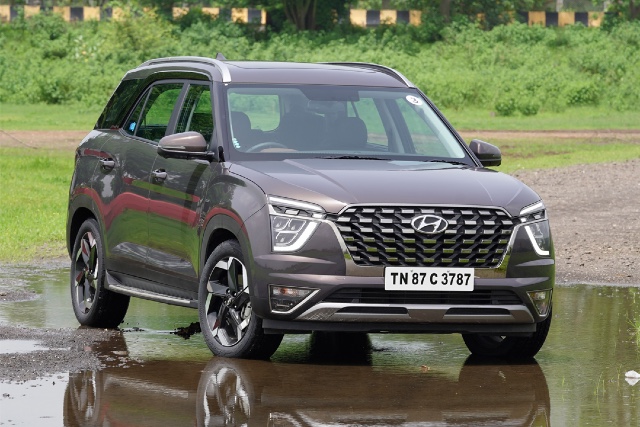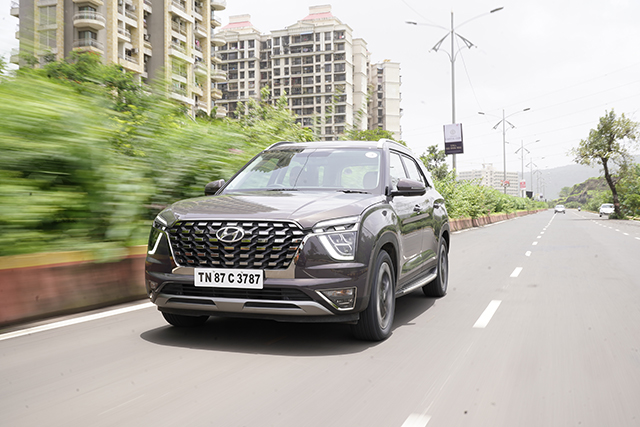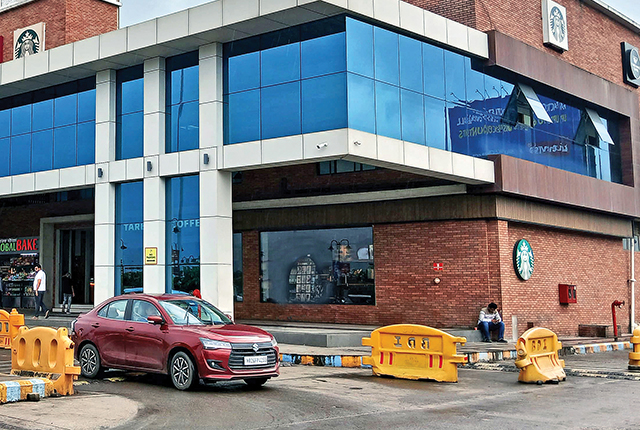Practically all major players have been trying to crack the three-row SUV space for a while now, and that’s why Hyundai have decided to pack their offering with tonnes of features even in the base variants.

Going with the trend, Hyundai launched the Alcazar in six-seat (with captain’s seats in the second row) and seven-seat (with middle-row bench seats) versions, with the option of petrol and diesel engines, as well as manual and automatic gearboxes.
Powertrain and Price
Engine options include a 2.0-litre, naturally-aspirated petrol engine that puts out 159 hp and 191 Nm. There’s also a 115 hp and 250 Nm, 1.5-litre option for those who prefer diesel. Both of these solely power the front wheels through either a six-speed manual or a six-speed automatic transmission. The Alcazar is being offered in three variants Prestige, Platinum and Signature and the automatic version comes with a few extra pieces of equipment. For now, the Alcazar is priced between Rs 16.30 lakh, and top off at Rs 19.99 lakh (ex-showroom) which might seem to be on the heavier side. So, here we are in the rain-soaked Mumbai trying to figure out if the price is justified.
[metaslider id=30293]
Design
First things first, the Alcazar might be based on the Creta but it managed to look distinct. Starting with the larger cascading grille with chunky chrome elements and a silver accent running from one headlamp to the other. The low-set headlamp design from the Creta has been carried forward and it comes with trio-beam headlamps and LED DRLs. While the turn signal and fog lamps are right at the bottom of the new bumper which also boasts of silver skid plates. The Alcazar has also grown in size and compared to the Creta is longer by 200 mm (4,500 mm), taller by 40 mm (1,675 mm) and even the wheelbase has increased 150 mm (2,760 mm) making it the longest in the segment. In fact, they’ve improved the ground clearance by 10 mm so even with a full load of six or seven people it can keep the belly from scraping over high speed-breakers.
The side profile is very different mainly due to the straighter roofline, integrated roof rails, raked C-pillar with the third-row glass window, extended rear fender and 18-inch diamond-cut wheels (Platinum trim and above) that are a size larger than Creta’s. Higher variants also get a side footboard, which gives it a more rugged stance. At the rear, there’s a new tailgate and spoiler, and different tail-lamps with honeycomb inspired texturing. A thick chrome strip carries the “ALCAZAR” nomenclature stamped on it, while the rear skid plates and trendy twin-tip exhaust complete the sporty stance. The Alcazar is readily distinguishable from its five-seater sibling and some even see a glimpse of the grand Hyundai Palisade, especially in the new face.
Cabin Design
The biggest talking point of the new model is its promise to offer generous cabin space and luxury-class features. You are in a modern, premium and hi-tech space.Though I’m not a big fan of brown interiors the black and cognac brown combo works well especially in our extravagant Signature trim. I also like the uncluttered dashboard layout with clean lines, a large display and easy to reach buttons and knobs all very ergonomically laid out. The front seats are large and comfortable, and the driver gets a height-adjustable seat, the versatility of tilt and telescopic steering and power-adjustable and folding mirrors. Our top-spec petrol automatic version also gets leatherette upholstery, ventilated seats and the convenience of powered seats. You get clear visibility because of the large glass area with bare minimum blind spots.
Captain Seats
Since we got our hands on the top-end six-seater version it came with a pair of comfy Captain seats in the second row, a useful centre armrest with twin-cup holders, wireless charging and storage space within. The doors get soft-touch panels and large pockets, while the manual blind offers much needed privacy when you’re stuck in the urban chaos. There’s decent knee room, more than ample headroom, a nice foldable table that conceals a retractable cup holder. All you need to do is rest your head on the soft headrest cushion and it completes a proper business class travel experience. (Also Read: Tata Safari Review)
Third Row Seats
Using the convenient single tumble function, the Captain seats roll over to make way for the third row. Clever bits like assist grip handle to make it easy to get in at the back. Space here isn’t as generous but people under 5-feet 7-inches should be able to squeeze in. Obviously, you can slide the middle row ahead to create more room, and tilt the last row’s backrest too. But the back-rest adjustment strap can only be reached through the boot, which is troublesome. There’s limited under-thigh support but young adults wouldn’t be complaining much because they get dedicated a-c vents, USB ports, cup holders, and quarter glass for better visibility and airiness. There’s a reasonable 180-litre boot to carry your cabin bag and you have the option of folding flat the last row to increase the storage area.
Features
Hyundai haven’t cut any corners and even the entry-level trims are loaded with features like a multifunctional leather-wrapped, flat-bottom steering wheel (a-la Creta); nice looking gear knob – also leather-wrapped; 64 colour ambient lighting and 10.25-inch touchscreen with Apple CarPlay and Android Auto, cooled glovebox, cruise control, auto climate control the list is practically endless.No matter which variant you zero in on, it will have keyless entry and start, you can use the key to remote start the Alcazar, voice-controlled panoramic sunroof, and the Hyundai Blue Link connected-car tech. The kit also includes a couple of wireless smartphone chargers — one in front and, in the six-seater, also in the second row. Talking of which, the rear windows also get manual sunshades, sliding and reclining second-row, reclining third-row and (hold your breath) a-c vents and USB chargers on all three rows of seats. Yes, all of this is standard equipment and that explains the higher-than-expected starting price.
Invest in the Platinum or Signature trims and you’ll get four additional airbags (six airbags in total), an electric parking brake, a much-needed air purifier, and comfy headrest cushions on the middle row seats. You’ll love the 360-degree view camera which offers multiple-angle views and guiding lines so you know exactly what’s around and where the car is going. But what makes the Alcazar stand out are some of the segment-first features like the 10.25-inch digital instrument cluster with premium graphics and colour. It has a bunch of interesting features too, my favourite being the blind view monitor. Before a turn, when you switch on the indicator, the camera under the wing mirror shows the turning side’s rearview… directly on the instrument dials. Brilliant and safe, and new to this segment. Plus you get an electrically powered driver’s seat and a thumping Bose sound system.
The 2.0-litre Petrol Engine
Being positioned above the Creta, the Alcazar gets a larger and more powerful 2.0-litre petrol engine. This is the third-gen of the engine and makes marginally more power (159 hp) and slightly less torque (191 Nm) than the second generation that powers the current Tucson. We got our hands on the automatic version which gets drive modes (Comfort, Eco, Sport) and traction control settings (Snow, Sand, Mud). This is quite a refined and smooth motor that got going effortlessly in the city traffic and offered decent low and mid-range power delivery. The gear shifts are linear and leave little to complain about. It’s easy to iron out the slightest of hesitation from the six-speed auto by tapping on the new-to-the-segment paddle shifters. But poke it harder and the engine feels strained, so it’s best to keep it in the sweet spot.
Alcazar Performance and Fuel Efficiency
For everyday use, there’s ample performance on demand, and our automatic Alcazar seemed to be not too far off the manual version’s 0-100km/h claim of 9.5 seconds. We did sample some of it on the expressway but our road test would testify it further. Hyundai say that they’ve increased the final gear ratio, which promises to improve fuel efficiency without hampering engine performance. The petrol AT claims to return 14.2 km/l which is impressively just 0.3 km/l less than the manual version. This makes a strong case for the automatic. If you live in a city like Mumbai, then the exceptional convenience and refinement it brings just seals the deal. What is even more impressive is that it gets disc brakes on all four wheels which deliver excellent stopping power.
The 1.5-litre Diesel Engine Performance
The diesel 1.5-litre turbo-diesel is borrowed from the Creta, but Hyundai have tweaked the power delivery and gear ratios to suit the bigger Alcazar. It still makes 115 hp and 250 Nm which give the 1435 kg SUV a decent power-to-weight ratio of 80.13 and the torque-to-weight ratio of 174.21. This really helps in the overall drivability, you rarely feel the need for a larger engine. The strength of Hyundai’s diesel engine is that they are very smooth with extremely low NVH levels. More so the manual gear shifts are effortless and the light clutch makes them easy to live with. And this particular one is efficient too, promising 20.4 km/l for the manual version, while the automatic claims 18.1 km/l.
Ride and Handling
The Mumbai roads gave us enough opportunity to test the low-speed ride quality of the Alcazar, but little chance for high-speed cornering and testing. The ride remains mostly composed thanks to the new hydraulic bump stops which keep everything nice and taut. Though not as light footed as the Creta, especially on these 18-inch wheels. This 4.5 meter SUV does manage to skim over broken roads and small potholes with only major knock filtering through to the cabin. The engineers have re-tuned the suspension to carry the extra load, yet offer a fairly comfortable ride.
Whatever chance we got to attack corners, the Alcazar did manage to impress us with its elegant road manners. For a sizable vehicle it doesn’t feel as big or heavy as it really is when you drive it around — be it in the congested urban roads or the free-flowing highway. Obviously, it is not as light and agile as the Creta but it drives around fast bends with surprising confidence. Yes, there’s a bit of roll but it’s not alarming nor does it feel like a handful. The Alcazar delivers the promise of being a well-built comfortable and safe family car that will pamper them like much-expensive premium cars.





















Leave a Reply